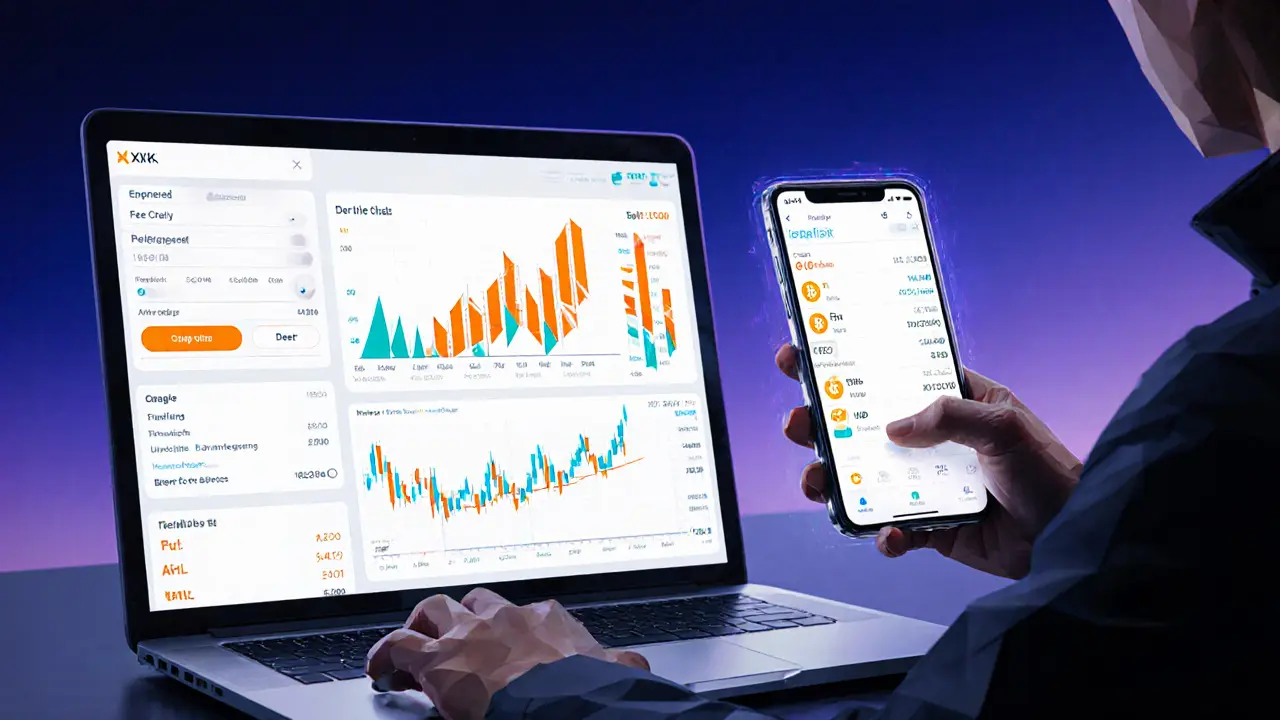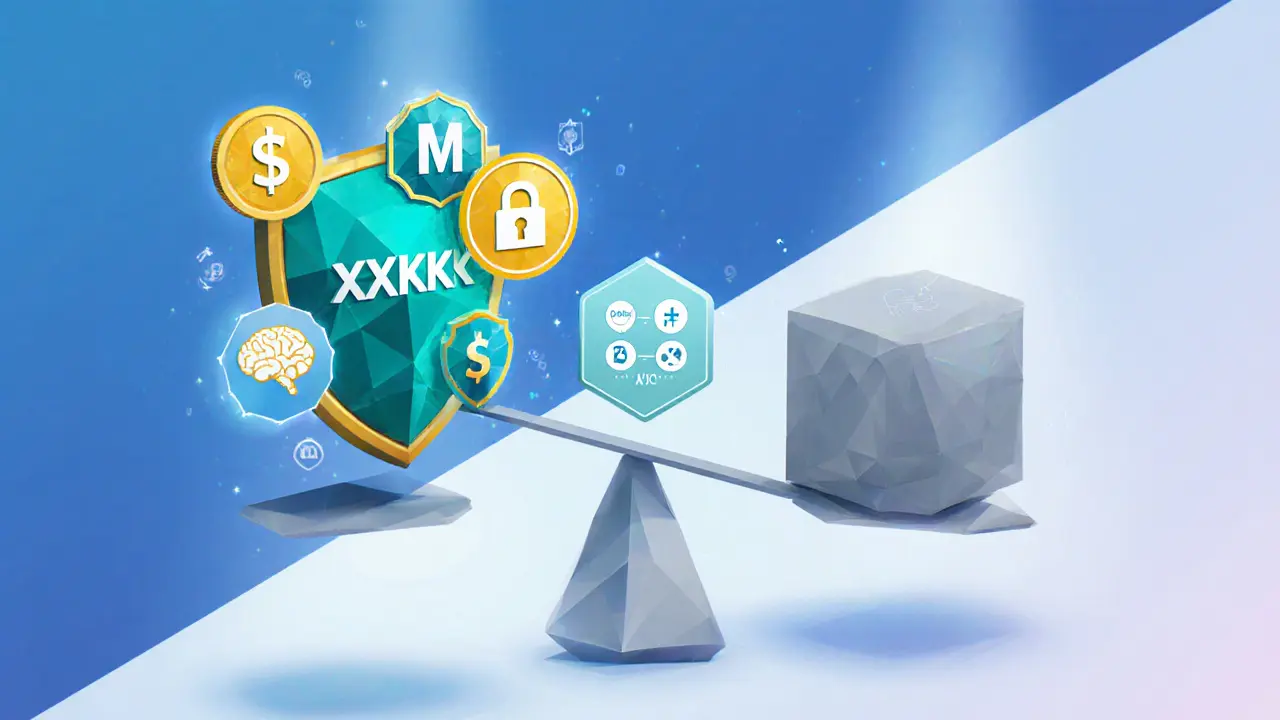XXKK Crypto Exchange Review - Security, Fees & User Experience (2025)
 Apr, 17 2025
Apr, 17 2025
XXKK Crypto Exchange Security Checker
Security Features
Check how XXKK compares to standard exchanges in key security areas.
Fee Calculator
Estimate trading costs for Bitcoin on XXKK exchange.
Security Feature Comparison
Trading Fee Estimator
Estimated Trading Costs
Fee: $0.00
Total Cost: $0.00
When you start looking for a place to trade Bitcoin, Ethereum or stablecoins, the first question is usually, “Is my money safe?” XXKK crypto exchange markets itself as a security‑first platform, promising low fees and fast execution while claiming zero major security incidents since its launch. This review breaks down what the exchange actually offers in 2025, where it shines, where it still hides details, and who might benefit most from signing up.
Security Architecture Overview
At the heart of XXKK’s promise is a modular, permission‑tiered architecture that separates the matching engine, risk management modules and transaction processing channels. By isolating each component, a breach in one area can’t automatically ripple across the whole system.
Key hardware protection comes from next‑generation Hardware Security Modules (HSMs) that store private keys in tamper‑resistant hardware. The HSMs use multi‑signature protocols and rotate keys on a quarterly schedule, a practice that dramatically cuts the window for key‑theft attacks.
On the user side, the platform layers several authentication steps. Standard Two‑Factor Authentication (2FA) is mandatory, and users can enable biometric authentication-fingerprint or facial recognition-through the mobile app. The login flow also includes behavioral modeling that flags anomalous device fingerprints or geo‑patterns, triggering a secondary verification prompt.
A real‑time risk engine monitors blockchain activity for suspicious patterns. If an address suddenly moves large sums or interacts with known malicious contracts, the engine can freeze the account and alert the security team within seconds.
The entire system undergoes quarterly penetration testing by an external security firm, and XXKK holds a SOC2 TypeI certification, which provides third‑party validation of its security controls.
Asset Protection and Risk Management
Beyond technical safeguards, XXKK has set aside a $1million asset protection fund. In the unlikely event of a systemic failure-say a catastrophic smart‑contract exploit-the fund is earmarked to reimburse affected users. While the amount may not cover the losses of high‑volume traders, it signals a concrete commitment to user protection that many newer exchanges lack.
The platform’s real‑time monitoring system operates 24/7, automatically isolating compromised accounts and preventing further withdrawals. Coupled with the multi‑layered defense strategy, this reduces the need for reactive “patch‑and‑pray” measures that have plagued other exchanges.
Compliance: AML & KYC
Regulatory pressure has forced most exchanges to tighten Anti‑Money‑Laundering (AML) and Know Your Customer (KYC) procedures. XXKK integrates an AI‑driven AML monitoring system that scans incoming and outgoing transactions in real time. Machine‑learning models flag atypical transaction sizes, rapid turnover, or transfers to high‑risk jurisdictions, automatically generating risk reports for the compliance team.
KYC verification is a multi‑step process that combines government‑issued ID checks, facial‑recognition matching, and dynamic risk scoring. For users in India, the platform has partnered with local document‑verification services, boosting approval rates and cutting the onboarding time to under five minutes for most accounts.
Cross‑border transfers undergo additional manual review if the destination country falls under heightened scrutiny, ensuring the exchange stays ahead of evolving international regulations.

User Onboarding & Trading Experience
The registration flow is streamlined: a new user enters an email, creates a password, and is prompted to set up 2FA. The AI‑assisted KYC runs in the background, and most users receive a “verified” badge within minutes. Once cleared, traders can immediately access the spot market for major assets such as Bitcoin (BTC), Ethereum (ETH) and USDT.
Order types include market, limit, and stop‑limit orders. The UI displays depth charts, recent trade history, and a customizable watchlist. For mobile users, the app mirrors the web experience, offering biometric login and push notifications for price alerts.
Liquidity appears solid for the three listed pairs, with average spreads comparable to larger exchanges. However, XXKK does not yet list a broad array of altcoins, which may limit traders looking for niche tokens.
Fee Structure & Trading Costs
XXKK advertises “low‑cost, high‑efficiency” trading but the public fee schedule is sparse. Based on typical industry models, we can infer a maker‑taker system where makers pay 0.08% and takers 0.12%. Deposit fees are generally zero for crypto, while fiat on‑ramps (where available) may carry a 1‑2% conversion surcharge.
Withdrawal fees follow the network‑optimal model: a flat fee that matches the current average blockchain transaction cost for the respective asset. This approach keeps costs transparent but can vary day‑to‑day with network congestion.
Since the exchange does not currently support margin or futures trading, there are no funding or leverage fees to consider, simplifying cost calculations for spot traders.
Pros, Cons, and Who Should Consider XXKK
- Pros:
- Strong security stack with HSMs, biometric login, and a real‑time risk engine.
- Dedicated $1M asset protection fund.
- AI‑driven AML/KYC that speeds up onboarding.
- Clean, low‑latency web and mobile UI for the core cryptocurrencies.
- Cons:
- Limited asset selection - only BTC, ETH, USDT are listed at launch.
- Fee schedule not fully disclosed on the public site.
- Lack of advanced product offerings (margin, derivatives, staking).
- Customer support response times are not documented, making post‑issue assistance uncertain.
- Best for:
- Security‑conscious traders who primarily deal with major coins.
- Users in regions where KYC verification is often a bottleneck (e.g., India).
- People who value a transparent, audit‑ready compliance posture.
Feature Comparison Snapshot
| Feature | XXKK Exchange | Typical Mid‑Size Exchange |
|---|---|---|
| Hardware Security Modules | Next‑gen HSMs with quarterly key rotation | Legacy HSMs, annual rotation |
| Two‑Factor + Biometric Login | 2FA mandatory + fingerprint/face ID | 2FA optional, limited biometric support |
| Real‑time Risk Engine | On‑chain activity monitoring, auto‑freeze | Periodic batch analysis |
| Asset Protection Fund | $1M guaranteed fund | None or ad‑hoc insurance |
| SOC2 TypeI Certification | Certified | Often pending |
| AI‑driven AML/KYC | Live ML models, sub‑5‑minute onboarding | Manual checks, 30‑60min lag |
| Supported Assets (as of Aug2025) | BTC, ETH, USDT | 20+ major coins, 100+ altcoins |

Frequently Asked Questions
Is XXKK Exchange safe for large deposits?
Yes, the exchange uses hardware security modules, multi‑signature key storage, and a $1M asset protection fund. While no platform can guarantee 100% safety, the layered defenses and SOC2 certification place XXKK among the more secure options for sizable holdings.
What fees will I pay when trading Bitcoin on XXKK?
The exact schedule isn’t public, but the exchange appears to follow a maker‑taker model around 0.08% for makers and 0.12% for takers. Deposit is free, and withdrawal costs match the current network fee for Bitcoin.
Can I use facial recognition on the mobile app?
Yes, the app supports both fingerprint and facial recognition for quick, secure login, provided your device hardware meets the OS requirements.
How does XXKK handle regulatory changes?
Because the platform built compliance into its core-from AI‑driven AML to region‑specific KYC-it can adapt faster than exchanges that rely on manual rule updates. The SOC2 TypeI audit also helps demonstrate ongoing adherence to best‑practice standards.
Why aren’t there many altcoins on XXKK?
XXKK’s current focus is on security and compliance for high‑volume assets. Adding dozens of low‑liquidity tokens would increase attack surface and regulatory complexity, so the team has opted for a lean launch and may expand later.


vipin kumar
April 17, 2025 AT 00:10I've been watching these crypto platforms for years and the moment they flaunt "next‑gen HSMs" I start wondering who's really in control of the keys. The press releases never mention the hidden backdoors that could be opened by government agencies or rogue insiders. Even the fingerprint/face ID 2FA sounds great until you realize biometric data can be duplicated or stolen. The real‑time risk engine they boast about is probably just a veneer to make traders feel safe while the actual monitoring is outsourced to a third party you can't even name. Asset protection funds are rarely ever paid out; remember that $1M guarantee that vanished after the last hack? SOC 2 certification is a paper badge, not a guarantee, especially when auditors are paid by the same firms they audit. AI‑driven AML/KYC sounds futuristic, but those models are trained on biased data and can freeze legitimate accounts in minutes. Every time I see a new fee calculator I suspect they're just shifting hidden costs into withdrawal fees. The maker‑taker model they show is a standard smoke‑screen; most users end up paying the taker fee because of latency. I've read that the exchange's code repository is private, so we have no way to verify if there are any malicious contracts lurking. The UI looks sleek, but that's just to distract you from the opaque terms buried in the fine print. If you think the exchange is safe because they advertise security features, think again – the real threat is the centralization of control. Remember what happened with other “secure” exchanges that got busted by insider leaks? The pattern repeats: hype, then a breach, then a scramble to reassure users. In short, treat every security claim with skepticism and never keep more than you can afford to lose on any platform.
Lara Cocchetti
April 21, 2025 AT 18:57The way they frame the security features feels like they’re trying to sell you peace of mind while ignoring the underlying ethical concerns. A platform that claims to protect assets must also be transparent about who has access to user data and how that data could be misused. It’s not just about tech; it’s about responsibility.
Mark Briggs
April 26, 2025 AT 13:44Cool marketing, but the fees are basically the same as every other exchange.
mannu kumar rajpoot
May 1, 2025 AT 08:31Everyone loves bragging about next‑gen hardware, but nobody asks who's actually maintaining those HSMs. If the staff are overworked or undertrained, any “state‑of‑the‑art” device can become a single point of failure. Also, the claim that biometric 2FA is mandatory sounds nice, but it forces users to hand over even more personal data, which could be harvested for other purposes. The risk engine’s auto‑freeze might sound protective, but it could also lock you out of your own funds without a clear appeal process. All these features are impressive on paper, yet they might create new vectors for abuse.
Tilly Fluf
May 6, 2025 AT 03:18Thank you for highlighting those concerns. While the technical specifications look promising, it is indeed crucial to evaluate the governance and oversight mechanisms that accompany them. Transparency reports and third‑party audits would go a long way toward building trust among users.
Darren R.
May 10, 2025 AT 22:05Honestly, the drama surrounding these exchanges never seems to end, and the promises of "AI‑driven AML" just feel like buzzwords to distract us from the fact that many platforms still rely on manual checks that are prone to error, bias, and delay. If you ask me, the whole ecosystem is built on a fragile foundation of trust that is constantly being tested by regulatory crackdowns, data breaches, and the perpetual tug‑of‑war between decentralization ideals and centralized control, which is why many newcomers end up feeling overwhelmed and skeptical about where to place their assets safely, and that’s a problem we need to address collectively.
Hardik Kanzariya
May 15, 2025 AT 16:52I hear you – the hype can be overwhelming. It helps to start small, maybe test the platform with a tiny amount, and watch how their support responds to any issues you raise. That way you can gauge both the tech and the team behind it.
Shanthan Jogavajjala
May 20, 2025 AT 11:39From a technical standpoint, the integration of real‑time monitoring could be a game changer, yet most users lack the jargon to differentiate genuine innovation from marketing fluff. The real question is whether the backend architecture can scale without compromising latency, especially during high‑volume market swings.
Karl Livingston
May 25, 2025 AT 06:26Great point! If the system can keep latency low, that would definitely boost trader confidence. But I also wonder about the fallback mechanisms if the real‑time engine crashes – do they have redundancies in place?
Kyle Hidding
May 30, 2025 AT 01:12Another thing – the fee calculator shows zero because they hide the network fees elsewhere. Classic move.
Andrea Tan
June 3, 2025 AT 19:59True, those hidden costs can add up fast. It’s always good to double‑check the actual withdrawal amounts after a trade.
Gaurav Gautam
June 8, 2025 AT 14:46I appreciate the thorough breakdown, but for newcomers the sheer amount of info can be intimidating. A simple step‑by‑step tutorial would make a huge difference in onboarding and confidence.
Robert Eliason
June 13, 2025 AT 09:33Exactly! Clear documentation and quick‑start guides are essential. Without them, even the best security features become inaccessible to many users.
Cody Harrington
June 18, 2025 AT 04:20Overall, the platform looks solid, but I’d still keep a close eye on community feedback before committing large sums.
Chris Hayes
June 22, 2025 AT 23:07Community sentiment is a great barometer – if the majority are cautious, that says a lot about underlying trust issues.
victor white
June 27, 2025 AT 17:54One cannot help but notice the elegant veneer, yet beneath lies the classic paradox of centralized security masquerading as decentralization. The more we scrutinize, the clearer it becomes that true resilience demands not just flashy features but verifiable, open‑source transparency.
mark gray
July 2, 2025 AT 12:41Agreed. Open‑source audits and community‑driven code reviews would go a long way toward bridging that trust gap.
Alie Thompson
July 7, 2025 AT 07:28It is incumbent upon us, as users, to demand not only cutting‑edge technology but also ethical stewardship; otherwise, we risk becoming pawns in a lucrative game played by those who wield the keys to our financial futures. The extraordinary promises of next‑gen security must be matched by concrete accountability mechanisms, transparent governance structures, and a steadfast commitment to user sovereignty. If the platform cannot demonstrate these principles, then its allure remains merely superficial, and prudent investors will wisely seek alternatives that prioritize integrity over spectacle.
Samuel Wilson
July 12, 2025 AT 02:15Indeed, accountability is essential. A clear roadmap for oversight, perhaps including periodic third‑party audits and an open forum for community concerns, would substantially enhance credibility.
Rae Harris
July 16, 2025 AT 21:02All this talk about security is great, but sometimes I feel like these platforms are just trying to out‑shout each other with buzzwords, and the real user experience gets lost in the hype.
Danny Locher
July 21, 2025 AT 15:49Sounds decent.
Emily Pelton
July 26, 2025 AT 10:36While the promotional language dazzles, it is paramount that we, as a community, maintain a vigilant stance and demand concrete evidence of these security guarantees; without verifiable data and transparent protocols, any claims remain speculative at best, and users deserve more than glossy marketing to protect their assets, which underscores the need for collective scrutiny and active dialogue.
sandi khardani
July 31, 2025 AT 05:23The platform's features sound impressive on paper, but real‑world performance and user protection hinge on thorough testing and transparent reporting, aspects that often get sidelined in favor of hype.
Donald Barrett
August 5, 2025 AT 00:10If you keep ignoring the red flags, you’ll end up paying the price when the next breach hits.